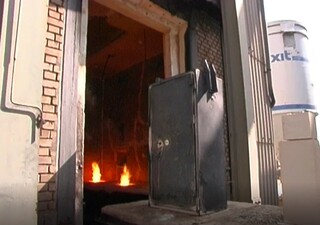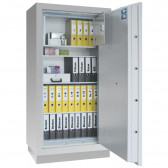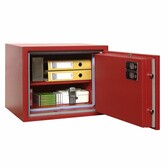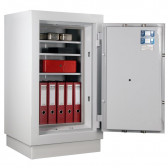Fire-resistant safes are a very important security feature and are used in both homes and businesses to protect precious items, valuables, important documents and data media from loss or damage. It would seem that a fireproof safe will adequately protect both paper documents and information stored on various types of data media from the effects of fire. Nothing could be further from the truth. It is worth remembering that these are separate product categories! Why are paper documents or media in safes without certificates likely to be destroyed and not protected against the effects of fire? Why should we not store media in safes with fire resistance for documents? It is useful to understand the differences between these types of safes in order to choose the right option to suit your individual needs.
Fire resistant safes
Fireproof safes are designed to protect and secure valuable items, including, above all, paper documents and data carriers from the impact, and indeed the effects, of high temperatures.
It is worth noting at this point that, in theory, any safe could be described as 'fireproof', but only in theory. Safes are made of steel – steel is one of the most durable materials – but when a safe heats up, the temperature inside it systematically rises, and this is where the proverbial stairs begin. If the temperature inside the safe rises too much, the deposit will be damaged or flooded (due to water or fire extinguishing agents). In contrast to standard safes, fire safes have:
• special layers of insulation and filling between the sheet metal shells (e.g. with salt added, as salt has a thermal function), which prevent the specified temperature inside the safe from being exceeded for a given period of time,
• a fireproof strip – located on the inner frame of the door or the perimeter of the body, which swells when exposed to high temperatures, thus filling the gaps in the structure.
Fire safes also have certificates confirming their level of fire resistance, awarded after passing tests.
Fire resistance tests – how do they work?
Before a safe is certified as fire resistant, it undergoes a fire and drop test. The safe is placed in an oven and heated for a specified time (e.g. 60 or 120 minutes), the temperature reaches 1090 °C. The still hot safe is then dropped from a height of 9.15 m to simulate the fall of the safe in the event of a ceiling collapse due to fire. The temperature inside during the entire test must not exceed 30 °C.
Paper fire safe
The maximum acceptable temperature for paper documents is assumed to be 170 °C. Fireproof paper safes will perfectly protect your documents, and the choice of a particular model depends on your needs.
The class of fire resistance is regulated by 2 standards:
• EN 15659 – you will find safes here with LFS 30 P and LFS 60 P (30 and 60 minutes fire resistance respectively),
• EN 1041-1 – here you will find safes with S 60 P, S 120 P (60 or 120 minutes fire resistance).
The main purpose of fireproof paper safes is to protect documents against the impact of fire. However, you can also store other valuables in these safes. Such a safe will work well in an office space as well as in a house or flat.
Fireproof media safe
As we store more and more information on electronic data carriers such as hard disks, memory sticks or memory cards – data media safes will prove ideal for protecting these values from the effects of fire.
These safes differ from traditional paper fire safes not only in terms of their purpose, but also in their design. They are specially designed to maintain lower internal temperatures to make them secure for electronic data storage media. It is understood that more temperature-sensitive storage media can be damaged or destroyed at temperatures as low as around 50 °C.
Fire-resistant home safes
Sometimes customers say that for domestic use, the simplest safe is enough for them. They are surprised when we point out that a sensible product should weigh min. 150 kg and have a fireproof certificate.
A fortuitous situation such as a fire, like a burglary, can occur in a company, an institution as well as in a house or flat. This is why the word 'precaution' is ideally suited to considering the question: is it worth investing in a fireproof safe for a house or flat?
Good, high-quality home fireproof safes meet strict quality standards, so they will work well for storing documents (passports, notarial contracts, etc.), other valuables, jewellery and even for securing firearms.
How are fireproof safes locked?
Modern fireproof safes have certified locks. Choosing a particular one depends on your preferences. Your safe can be locked with a standard key lock. You can optionally choose: an electronic lock ( on a PIN code), a combination lock (you set the appropriate cipher on the dial) or even a biometric lock (which works on a fingerprint).
Choice between safes
The choice between a fireproof paper safe and a media safe depends on the individual needs of a user. Those who store mainly paper documents may find paper fireproof safes more economical compared to media safes. On the other hand, those who have valuable electronic data storage media should look at safes specifically tailored for this purpose and – despite the higher price – invest in them, after all, this is protection for years to come.
Summary
Fireproof paper safes and media safes serve different functions, tailored to different storage needs. Whichever you choose, the key is to understand the differences between the two and to tailor the safe to the specific values you want to protect. Whether it's important paper documents or valuable electronic storage media, the right safe provides protection against loss and destruction in the event of a fire. Fireproof safes are excellent burglary protection and will work well in office spaces as well as in a home office or dressing room.
We also recommend other articles: Fireproof cabinets and safes in the workplace





